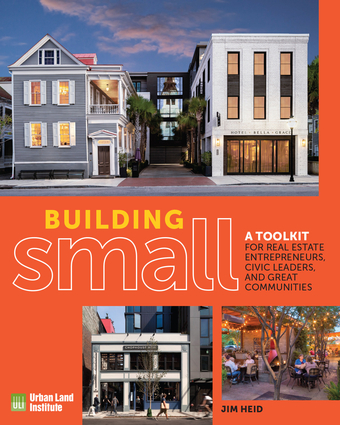

Building Small
A Toolkit for Real Estate Entrepreneurs, Civic Leaders, and Great Communities
0-3
ARCHITECTURE
264 Pages, 8 x 10
Formats: Paperback, ebook: EPUB
Paperback, $49.95 (US $49.95) (CA $66.95)
Publication Date: March 2021
ISBN 9780874204681
Overview
Small-scale, incremental real estate development is gaining momentum as an alternative to more conventional approaches. Small-scale development helps create authentic places, acts as a magnet for new investment, and helps attract talent-based employment, all while fostering a more resilient local economy. This, in turn, helps communities better differentiate themselves when seeking new investment in an increasingly competitive landscape. Despite those virtues, entrepreneurial developers working to “build small” face jurisdictional and capital barriers that impede bringing this approach to scale. Drawing on extensive research and using case studies, interviews with over 100 developers, and first-hand knowledge gained from tours of several U.S. cities, author Jim Heid articulates what small-scale development means, why it is essential to communities of every size and in every location, and how entrepreneurial developers and community leaders can help remove obstacles to small—delivering successful projects and resulting in a better approach to building community.Reviews
"This book captures a profound truth about placemaking: that Building Small can foster economic prosperity without sacrificing human vitality. By focusing on context and on incremental, varied, and fine grained development, Building Small allows places evolve over time..." —Mark Elison Hoversten, PhD, FASLA, AICP, Dean of the College of Design, North Carolina State University"I’ve got this open on my desk right now - mining the toolkit, success stories and case studies for gems and no-nonsense advice as I run across challenges in my own projects... The success stories, particularly the ones for public agencies, make it really simple to replicate." —Molly McCabe, President and Founder, Hayden + Tanner
"Building Small is a must have book not only for small developers but also for anyone involved in the remaking of US cities... Heid takes the reader through the classic steps of the real estate development process, but with a focus on the particular hurdles that small developers face." —Donald K. Carter, FAIA FAICP, LEED AP, Senior Research Fellow, Remaking Cities Institute, School of Architecture, Carnegie Mellon University
"Building Small offers developers and communities an alternative to more conventional development... It shows the way toward solutions that are finer-grained, context-sensitive, and market-responsive. Importantly, the book is aimed at both the private and the public sector, recognizing that the best outcomes require a creative approach on both sides..." —Patrick Phillips, Former Global CEO, ULI





